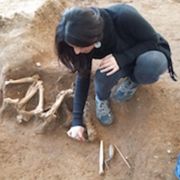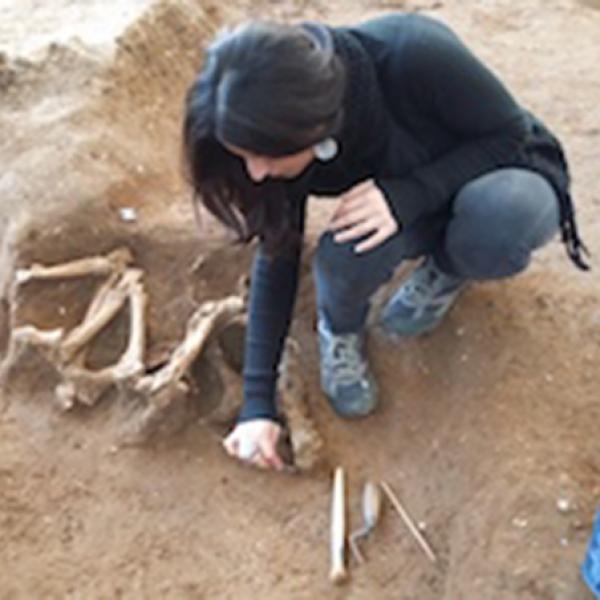Yasha Hourani
School of Biosciences
Research Student
Thesis- Animal exploitation in ancient Beirut from the Persian to the Umayyad period (6th century BC – 8th century AD): an archaeozoological approach


Full contact details
School of Biosciences
Minalloy House
10-16 Regent Street
Sheffield
S1 3NJ
- Qualifications
-
- 2007 – 2009- Masters Degree in Quaternary and Prehistory – The National Museum of Natural History, Paris (Final grade: 16/20 – rank: Very Good)
- Thesis- “Archaeozoological approach and taxonomic characterization of an equine accumulation at the Roman site JEM002 (Beirut)” (Supervisors: Tarek Oueslati, Marjan Mashkour, Sandrine Grouard. Grade: 18/20 – rank: Very Good)
- 2001 – 2005- Bachelor’s Degree in Archaeology and History of Art – Université Saint-Esprit de Kaslik, Lebanon. (Final grade: 16/20 – rank: Very Good)
- 2007 – 2009- Masters Degree in Quaternary and Prehistory – The National Museum of Natural History, Paris (Final grade: 16/20 – rank: Very Good)
- Research interests
-
Thesis- Animal exploitation in ancient Beirut from the Persian to the Umayyad period (6th century BC – 8th century AD): an archaeozoological approach
- Supervisors- Professor Umberto Albarella & Dr Jane Rempel
Thesis Abstract
This project aims at exploring economic and socio-cultural aspects of animal exploitation in ancient Beirut.
The research is based on the analysis of faunal material from four sites excavated between 2013 and 2015. Assemblages from Persian, Hellenistic, Roman, Byzantine and Umayyad levels will serve to investigate the organisation of production and consumption of animal products in each period, and to follow the evolution of animal management strategies through the different periods.
The main goal is to produce a substantial and original contribution to our understanding of food customs, herd management strategies, provisioning systems, butchery techniques, culinary practices and waste management in the urban environment of Beirut.
Furthermore, changes in the morphology of domestic mammals and birds, as well as animal health and its socio-economic implications on animal management, will be addressed.
The study also aims to fill an important gap in our understanding of the cultural practices and beliefs which characterised the Beirut population.
Aspects of past human-animal relationships beyond mere consumption will be addressed through the study of animal burials and remains found in ritual contexts.
The research project will contribute to the wider theoretical debate about the growth of the classical city and the reasons behind the shrinkage of the urban territory in the Umayyad period.
It will also shed light on the extent of external influences, driven by contact with new populations, on local socio-cultural life, and contribute to the explanation of continuities and changes, corresponding to the Hellenisation, Romanisation, Christianisation and Islamisation of the city.
Finally, the results will be interpreted in a regional perspective, and animal movement and introduction of exotic species in the Eastern Mediterranean will be investigated.
- Grants
-
Awards & Scholarships
- 2018 – 2021- University of Sheffield Faculty of Arts and Humanities PhD Scholarship Award
- 2007- Mobility Grant – Université Saint-Esprit de Kaslik, Lebanon
- 2002 – 2005- Merit Scholarship – Université Saint-Esprit de Kaslik, Lebanon
- Publications
-
Publications
-
-
Hourani, Y. (2018) Persian Period Dog Burials of Beirut: Morphology, Health, Mortality and Mortuary Practices. In C. Çakirlar, J. Chahoud, R. Berthon and S. Pilaar Birch (eds) Archaeozoology of the Near East XII. Proceedings of the 12th International Symposium of the ICAZ Archaeozoology of Southwest Asia and Adjacent Areas Working Group, Groningen Institute of Archaeology, June 14-15 2015, University of Groningen, the Netherlands, 153-184.
-
Hourani, Y. (2018) Congenital anomalies and traumatic injuries in dogs from Laodicea in Canaan (Hellenistic Beirut, Lebanon). In L. Bartosiewicz and E. Gál (eds) Care or Neglect?: Evidence of animal Disease in Archaeology. Proceedings of the 6th meeting of the Animal Palaeopathology Working Group of the International Council for Archaeozoology (ICAZ), Budapest, Hungary, 2016, 79–96. Oxford, Oxbow books.
-
Hourani, Y. and Oueslati, T. (2017) Une accumulation d’équidés à Berytus : approche taxinomique et taphonomique. In M. Mashour and M. Beech (eds) Archaeozoology of the Near East 9. Proceedings of the 9th conference of the ASWA (AA) Working Group. Archaeozoology of SouthWest Asia and Adjacent Areas, 411-430. Oxford, Oxbow books.
-
Elias, N., Hourani, Y., Arbogast R.M. et al. (2017) Human and Cattle Remains in a Simultaneous Deposit in the Hellenistic Necropolis of Jal al Bahr in Tyre: Initial investigations. BMSAP (Bulletins et Mémoires de la Société d’Anthropologie de Paris) 29, 19-32.
-
Elias, N., Hourani, Y., Arbogast, R.M., Sachau-Carcel, G., Badawi, A., Castex, D. (2016) Archaeological and biological investigations of a simultaneous deposit of human and cattle remains in Jal al Bahr Hellenistic necropolis (Tyre), an attempt at interpretation. Bulletin d’Archéologie et d’Architecture Libanaises 16, 347-370.
-
-
Conference Papers
-
-
8 June 2017: ‘Faunal remains from the Chalcolithic levels at RML 79, an ephemeral settlement in Beirut (Lebanon)’. The 13th International Meeting of the ICAZ Archaeozoology of SouthWest Asia and Adjacent Areas Working Group, Nicosia, Cyprus (oral presentation)
-
27 May 2016: ‘Canine pathology: insight into Persian and Hellenistic period dog burials from Beirut, Lebanon’. The 6th International Meeting of the ICAZ Animal Palaeopathology Working Group, Budapest, Hungary (oral presentation)
-
12 June 2015: ‘Life and death of dogs in Persian and Hellenistic Beirut: Evidence from the burials’. The 12th International Meeting of the ICAZ Archaeozoology of SouthWest Asia and Adjacent Areas Working Group, Groningen, The Netherlands (oral presentation).
-
9 June 2014: ‘Burial or not? The case of men and cattle deposit in the Hellenistic necropolis of Jal al Bahr in Tyre’. The 9th ICAANE conference (International Congress on the Archaeology of the Ancient Near East), Basel, Switzerland (oral presentation).
-
28-30 June 2011: ‘Catastrophic death of seven equids and a camel in Byzantine Beirut’. The 10th International Meeting of the ICAZ Archaeozoology of SouthWest Asia and Adjacent Areas Working Group, Brussels, Belgium (poster presentation).
-
-
